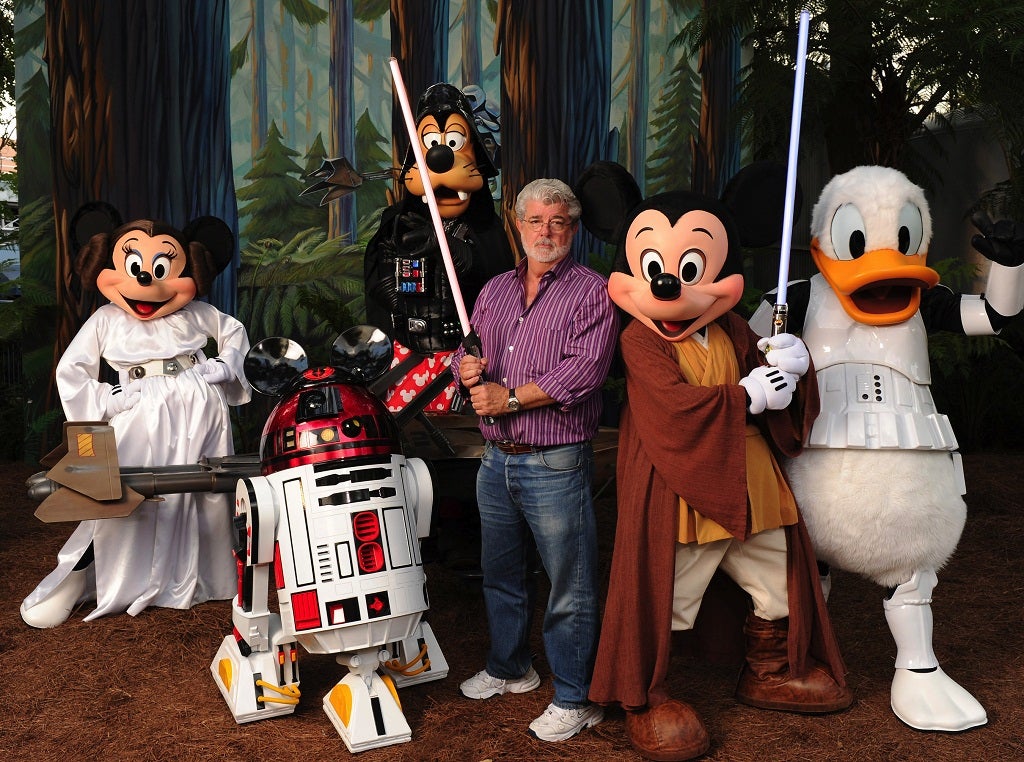Walt Disney buying Lucasfilm makes perfect sense for both parties - but for Star Wars fans especially
It is the loyalty of Star Wars fans that Disney has spent big bucks to purchase

The acquisitions and mergers types must be having sleepless nights. Having just got over the purchase of Penguin by Random House, they are now required to process the information that Walt Disney has bought Lucasfilm, home of the Star Wars franchise, for a cool $4.05bn (£2.5bn). It is official. The House of Mouse has become the Death Star. It is an eye-watering sum, but does it make any financial sense? Of course it does.
Disney is the obvious home for Star Wars, given that the franchise under George Lucas was steadily running out of creative steam. And it still generates enormous profits through sales of almost everything connected to the movies, from computer games to M&M dispensers.
For some time now, it has become apparent that Star Wars had become a bit of an albatross around Lucas’s bearded neck. Having altered the course of movie-making (or rather movie financing and merchandising) with his first Star Wars film, the series has seen diminishing returns. Artistically, they have suffered dreadfully. Commercially, they have been a solid prospect because of the size of the fanbase. Once a Stars Wars fan, always a Stars Wars fan. And it is this unswerving, unquestioning, unthinking loyalty that Disney has purchased.
Adroit
What Disney can do with the films themselves is a moot point – and they may well improve under their banner – but what they can do with the merchandise is beyond question. They are going to trouser countless millions.
While the Disney organisation has always been adroit at merchandising and marketing movie-based products from Donald Duck alarm clocks to plaster figurines of Snow White, Stars Wars was the first film to properly exploit the market beyond the film itself on an industrial scale. Stars Wars figurines, models and ephemera flew off the shelves with the speed of the Millennium Falcon. Early figures proved a wise investment and now command huge sums on internet auction sites.
Then came the computer games and digital spin-offs where the big bucks lie. Once you’re past the opening weekend box-office figures, the profits from cinema exhibition are relatively negligible compared with the money that can be raked in through merchandising. And there is no smarter or more ruthless merchandising operation on the planet than Disney.
Having established a connection in 1987 with the Star Tours theme park ride at Disneyland, Lucas introduced Mickey Mouse and his friends to various Stars Wars characters in a variety of other merchandising conduits over the years. Lucas, it appears, has never been shy about playing a long game. But neither has Disney.
Perfect Timing
In many respects, Disney has bought a ready-to-exploit franchise. They don’t have to repair, reboot, reinvent or reinstate anything: the market exists and it isn’t going away any time soon. Their timing is perfect, too. The last Stars Wars film, Revenge Of The Sith, was released in 2005 and fans have been anxiously trawling the internet ever since for confirmation of a follow-up. Disney has announced that they will release a new Stars Wars movie in 2015. The game plan, as far as I understand it, is to keep on making Stars Wars movies to infinity and beyond.
They have the back catalogue of Lucas’s six movies and all the peripheral activities that they can keep pushing onto an ever hungry public. They now have carte blanche to make more movies for both cinema exhibition and the DVD market; a practice they have been operating for decades with “sequels” to hit movies that have never seen light of the public screen. They have announced their intention to create a Stars Wars television series for their Disney XD channel. And that doesn’t take into account the advances they are making into new digital platforms of distribution, including video on demand and interactive websites.
The self-evident fact is that Disney is now far better at making capital out of existing material than creating its own at source. The corporation is a branding monolith and in the past decade has gobbled up Pixar Studios (2006) and Marvel Comics (2009). The acquisition of Lucasfilm is another giant leap for Mousekind.
Buzz
Franchise has been the buzzword in Hollywood for some time. Every executive wants one. In the UK, the successful rethinking of the James Bond films has delivered a real shot in the arm to the industry and the rebooted Dr Who has given the BBC more leverage in the international television market than it has had for decades.
But even franchises have their sell-by date and sequels have operated in the past according to the law of diminishing returns. Aside from a clutch of horror and SF franchises (Elm Street, Halloween, Star Trek, Alien, Predator) most potential franchises don’t get past the second sequel before petering out. The Bourne films, for example, are unlikely to reach the pensionable age of 007.
Star Wars is different and Disney knows it. Lucas planned his original concept as a nine-film cycle, shifting back and forth in time to expand the universe of his creation like God using an iPad. Now that he has passed the baton to his fellow Masters of the Movie Universe after making six of them, there are likely to be many more than the allotted three to come.
The question is: How many more plastic lightsabers or Darth Vader voice-changer helmets can the planet support? And will our children’s children be starting the day on a bowl of C3PO cereal? We are about to find out.
Join our commenting forum
Join thought-provoking conversations, follow other Independent readers and see their replies
Comments